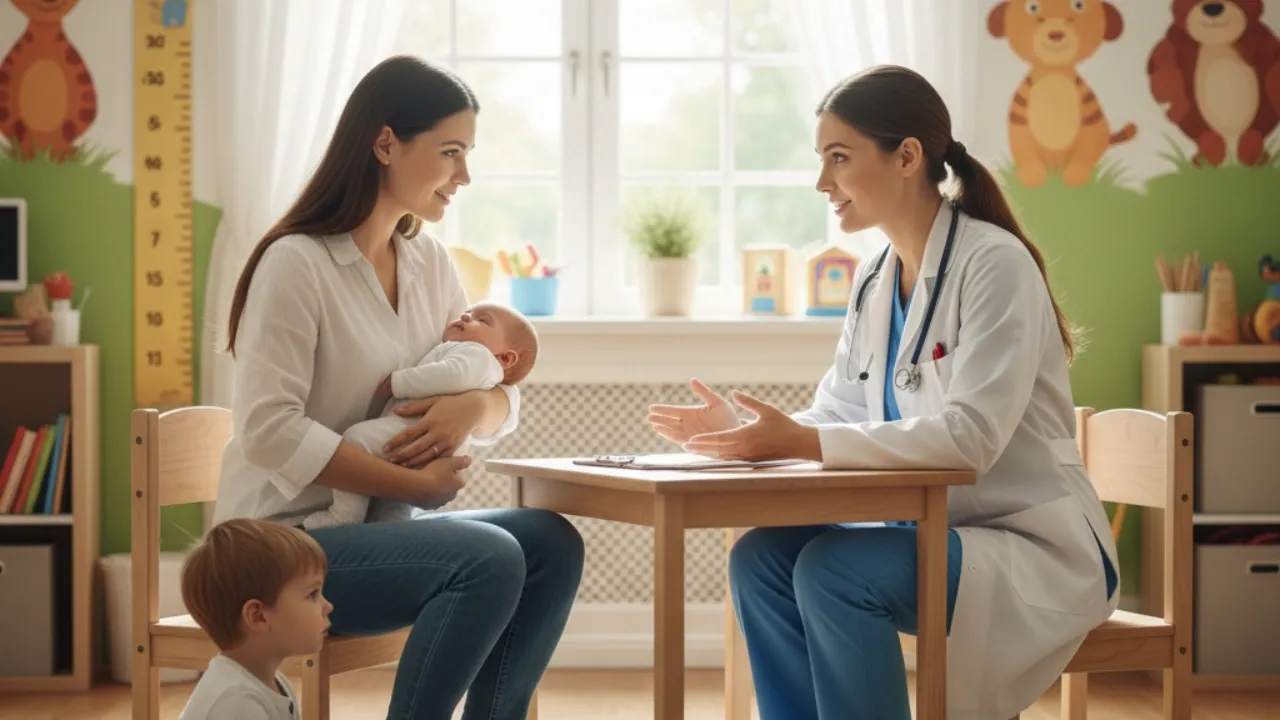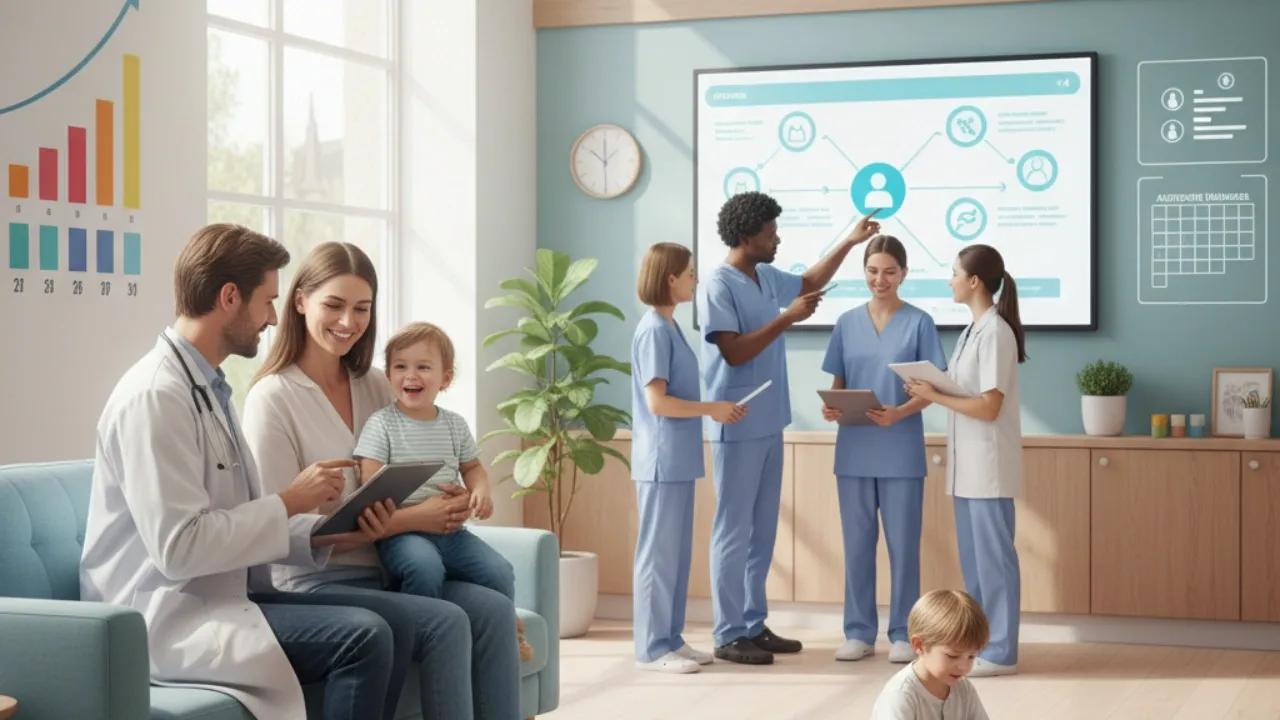
In pediatric practice, anamnesis is not just the “history of illness”—it’s the child’s timeline, connecting gestational data, developmental milestones, family environment, school, vaccination, and habits—always mediated by the legal guardian and, progressively, by the child. A well-designed model reduces gaps, guides decisions, and strengthens the relationship with the family.
Unlike specialties centered on the patient’s direct narrative, pediatrics requires a dual approach: listening to the guardian (context, perceptions, routine) and, according to age, listening to the child/adolescent (symptoms, emotions, autonomy). Each layer of information can shift the diagnostic hypothesis and care decisions. In this article, we present a complete pediatric anamnesis model, ready to be configured as a structured form in Ninsaúde Clinic.
The Importance of Anamnesis in Pediatrics
Pediatric anamnesis guides testing, prevents unnecessary interventions, and enables early identification of biological and psychosocial risk factors. Key objectives include:
- Reconstruct relevant gestational, perinatal, and neonatal history.
- Track neuropsychomotor and language development milestones.
- Assess age-appropriate habits (sleep, diet, elimination, screens/physical activity).
- Verify vaccination schedule and post-vaccine adverse events.
- Map family environment, school/daycare, home safety, and exposure to risks.
- Investigate age-specific red flags.
- Establish a channel of trust with guardians and with the child/adolescent.
Standardizing this script enhances clinical safety, comparability between visits, and care coordination across multidisciplinary teams.

Recommended Structure for the Pediatric Anamnesis Model
A good model balances objectivity (structured fields, checkboxes) with narrative (free-text history). Below is a section-by-section proposal—ready to convert into Ninsaúde Clinic forms.
1) Identification and Chief Concern
Essential fields:
- Child data (name, age, sex, school/grade, legal guardian and relationship).
- Who brings the child? Shared custody/authorization? Emergency contacts.
- Chief complaint (in the guardian’s and/or the child’s own words).
- Onset and course: date, context, aggravating/relieving factors.
Example: “Fever for 48 hours, nighttime peaks, decreased appetite; no vomiting.”
2) History of Present Illness (HPI)
Detail chronologically and qualitatively:
- Specific symptoms (fever, cough, diarrhea, pain, skin lesions, school concerns).
- Intensity, frequency, duration; relation to feeding/sleep/exertion.
- Medications already used (dose/interval), response, adverse effects.
- Exposure to sick contacts, recent travel, daycare/school (outbreaks).
- Functional impact: play, school, mood, sleep.
3) Gestational, Perinatal, and Neonatal History
- Maternal age, prenatal care (number of visits, complications), medication use.
- Delivery type, GA at birth, weight/length/HC, Apgar, NICU stay, jaundice.
- Newborn screenings (metabolic “heel prick,” hearing, eye, heart, tongue-tie) and results.
- Breastfeeding (exclusive? until when?), complementary feeding, early allergies.
4) Growth and Development
- Growth curves (weight, height, BMI-for-age, HC-for-age): trajectories and deviations.
- Motor milestones (head control, sitting, crawling, walking, running),
language (babbling, words, phrases), socioemotional (interaction, symbolic play). - School concerns: attention, reading, writing, math; prior referrals.
- Screening for ASD/ADHD when pertinent; socialization observations.
5) Immunizations
- Up-to-date or delayed schedule? Vaccination card entries.
- Post-vaccine adverse events.
- Catch-up needs per age/local epidemiology.

6) Nutrition, Sleep, and Elimination
- Diet pattern (variety, ultraprocessed foods, iron, calcium, hydration).
- Sleep (schedule, awakenings, snoring, suspected apnea, sleep hygiene).
- Elimination (stool frequency, pain, constipation, enuresis/encopresis).
- Screens and physical activity (daily screen time, active play, sports).
7) Allergies, Medications, and Past Medical History
- Allergies (food, drugs, environmental) and severity (anaphylaxis?).
- Chronic medications, supplements (iron, vitamin D).
- Hospitalizations, surgeries, trauma, seizures, chronic diseases (asthma, T1D, cardiopathies).
8) Environment, School, and Safety
- Housing (water, sanitation, pets, mold, secondhand smoke).
- School/daycare: adaptation, performance, relationships with peers/teachers.
- Safety: car seat/seatbelt, medication storage, window guards/screens, pool safety.
- Socioeconomic context and access to transport/health services.
9) Family History
- Genetic disorders, allergies, asthma, cardiopathies, epilepsy, neurodevelopmental disorders.
- Obesity, diabetes, hypertension, early dyslipidemia; sudden deaths.
- Family mental health (depression, anxiety), substance use.
10) Psychosocial Assessment and Bonding
- Mood, irritability, behavioral regression, recurrent pain without clear organic cause.
- Family routine, parental stress, social support.
11) Adolescent Interview (when applicable)
Use the HEEADSSS framework (summary domains):
Home, Education, Eating, Activities, Drugs, Sexuality, Suicide/mental health, Safety.
Always preserve age-appropriate confidentiality and inform the guardian per local law.
12) Prior Tests and Follow-ups
- Lab/imaging results; multidisciplinary assessments (SLP, OT, PT, educational psychology).
- Referrals made and adherence to treatment plans.
Age-Specific Red Flags
Document and automatically highlight in the EHR when present:
- Infants: fever in <3 months, persistent feeding refusal, bilious vomiting, lethargy, cyanosis, respiratory distress, dehydration, loss of motor milestones.
- Preschoolers: severe/progressive abdominal pain, neck stiffness, morning headache with vomiting, language regression, limping without trauma.
- School-age/Adolescents: unintentional weight loss, exertional syncope, exertional chest pain, suicidal ideation, suspected violence/abuse, substance use.
These findings should trigger prioritization protocols, safety counseling, and, when necessary, immediate referral.
Communication Best Practices with Families
- Active listening and plain language: welcome concerns, validate perceptions.
- Child-centered approach: involve the child according to maturity; explain what will be done.
- Clear written guidance: dosing, warning signs, when to return/tele-guide.
- Avoid judgment: especially around diet, screens, and discipline.
- HIPAA and ethics: obtain consent for records, photos, sending materials, and telehealth (and comply with local/state regulations).
A welcoming environment (posture, tone of voice, time for questions) reduces anxiety, improves adherence, and strengthens longitudinal relationships.
How to Implement the Model in Ninsaúde Clinic
Standardize with agility: convert the structure above into forms with picklists, dates, scales, and free-text fields. Practical suggestions:
- Age-specific forms (0–2, 3–5, 6–11, 12–18) with conditional blocks (e.g., HEEADSSS only for adolescents).
- Growth curves: calculated fields (BMI-for-age) and curve attachments; record percentiles and z-scores.
- Vaccines: age-based checklist with alerts for overdue doses (CRM/task trigger for reminders).
- Red flags: checkboxes that trigger a visual alert and priority triage.
- Protocols: standardized care plans by condition (asthma, constipation, obesity) with patient education.
- Ninsaúde Sign: electronic consent for vaccines, procedures, telehealth, and information sharing.
- Ninsaúde Safe: record complex instructions (e.g., asthma action plan) for later family review.
- Ninsaúde Pay: upfront billing for procedures/vaccines and follow-up packages (e.g., well-child care).
- Schedule & CRM: well-child visit program by age, vaccine recalls, and automated follow-ups (WhatsApp/Email).
- Open API: integrate with BI (e.g., Power BI) for dashboards on vaccine coverage, BMI by age, no-shows, and care-plan adherence.
Expected Benefits of Standardization
By adopting a structured model in Ninsaúde Clinic, clinics tend to see:
- Greater safety and consistency across visits (fewer omissions).
- Better tracking of growth/development and vaccination coverage.
- Less rework and fewer unnecessary test orders.
- Higher family satisfaction (clear guidance, proactive reminders).
- Multidisciplinary integration (pediatrics, SLP, OT, nutrition, psychology).
- High-quality data for audit, quality, and evidence-based decisions.
- Easier onboarding for new staff with established workflows.
- Greater operational predictability (well-child schedules and automated recalls).

A New Lens on Pediatric Care
Pediatric anamnesis is living: it grows with the child and family. When structured and humanized, it anticipates risks, guides choices, and turns each visit into an opportunity for education and prevention. With standardization, technology, and empathetic communication, clinics raise the bar of care—and families notice.

